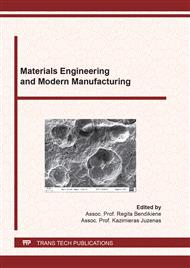p.3
p.8
p.14
p.20
p.31
p.37
p.43
p.49
Comparison of Stress-Strain States of Rail-Wheel Pair Made of Steel and MoNiCa
Abstract:
Contact interaction in a wheel-rail pair and its corresponding stress-strain state for various combinations of materials of this pair and the weights of passenger and freight cars were considered. The materials under study were steel and high-strength cast iron based structural material MoNiCa with strength and wear-fatigue characteristics close to steel ones.The load on each wheel was: 53.9 and 294.3 kN for an empty and loaded freight car, 146.8 kN and 230.5 kN for an empty and loaded passenger car. The bottom surface of the rail was rigidly fixed.Young's modules were adopted as follows: 200 GPa for steel and 165 for MoNiCa. The results of finite element calculations of the three-dimensional stress-strain state showed that the largest von Mises stresses of 613.08 MPa occur in the wheel (steel)-rail (steel) pair of the loaded freight car. For all types of loading, the lowest stresses (15.8 % – 16.7 % less than in the steel-steel pair) are observed in the wheel (MoNiCa)-rail (MoNiCa) pair. This indicates the appropriateness of using MoNiCa for the manufacturing elements of the wheel-rail system.
Info:
Periodical:
Pages:
14-19
Citation:
Online since:
June 2021
Price:
Сopyright:
© 2021 Trans Tech Publications Ltd. All Rights Reserved
Share:
Citation:


